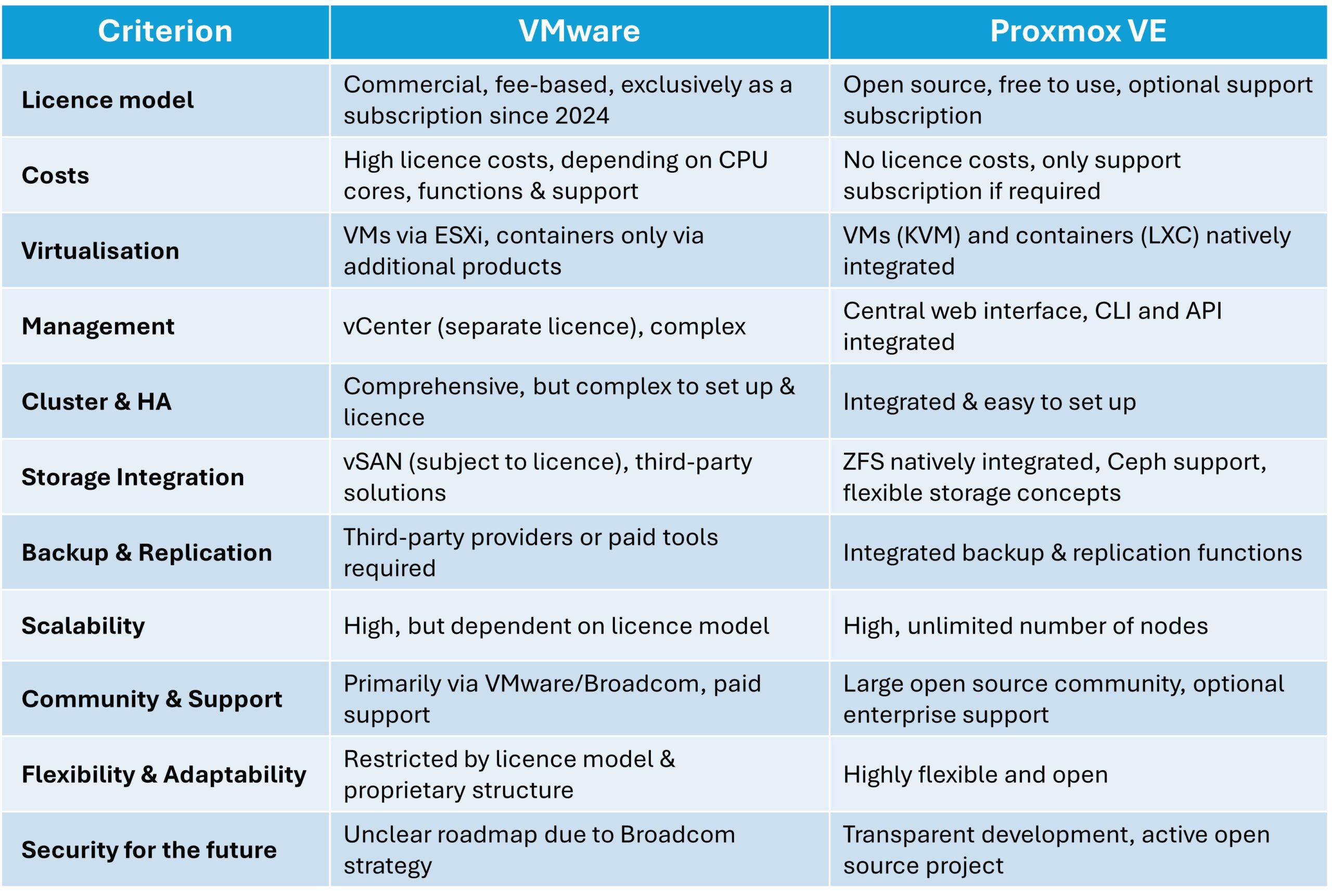Virtualization as a Lucrative Business Model
Virtualizing IT infrastructures is now standard in companies of all sizes. VMware has long been considered the undisputed leader in this field: powerful and stable, widely known and with extensive features. However, with Broadcom’s acquisition of VMware at the end of 2023, the market has changed.
Numerous companies are suddenly facing challenges: new licensing models, increased costs, and uncertainties about Broadcom’s future product strategy are causing many IT managers to question their infrastructure. Particularly affected are managed service providers, mid-sized companies, and organizations that have previously relied on proven VMware technologies such as ESXi, vSphere, or vCenter.
Although Broadcom is still recording healthy profits with its subscription model for VMware in the first quarter of 2025, there is likely to be a significant number of customers willing to switch and considering new options, given the dissatisfaction of many with the provider’s business practices.
In these considerations, more and more IT decision-makers are turning to a transparent and economical open-source alternative: Proxmox VE. As an official Proxmox hosting partner, we show in this article the advantages and disadvantages of Proxmox vs. VMware. We address the question of why switching to Proxmox might make sense for your company and show what you should consider when migrating.
What is Proxmox?
Proxmox VE (Virtual Environment) is an open-source virtualization platform that combines virtual machines (VMs) with KVM and containers with LXC through its central web interface. Since its first release in 2008, Proxmox, which has an active community and regularly provides releases, has become one of the most popular open-source solutions in the field of server virtualization.
With Proxmox, companies receive a transparent and enterprise-capable virtualization platform that reliably supports both small IT environments and complex cluster structures. As with any open-source solution, users remain independent of proprietary license models owned by a manufacturer.
Features of Proxmox VE:
- Fully integrated support for KVM-based VMs and LXC containers
- Central management via a modern web interface or CLI/API
- Support for clustering, high availability, and live migration
- Integrated backup and snapshot functions
- Native ZFS support and flexible storage options (Ceph, iSCSI, NFS etc.)
Thanks to its open architecture, Proxmox is not only popular among open-source advocates but is increasingly being used professionally by companies and service providers: Including official Proxmox Hosting Partners like firstcolo.
Proxmox vs. VMware: Why Are Many Companies Looking for an Alternative to VMware?
The acquisition of VMware by Broadcom caused a lot of stir and criticism in the IT world. What was originally announced as an expansion of Broadcom’s portfolio quickly became a challenge for many VMware customers: The transition to a pure subscription model was particularly critically received. This was associated with sometimes drastic price increases, limited flexibility, and uncertainty regarding future product development.
The points of criticism at a glance:
- License costs are rising significantly: The previous perpetual licenses have been discontinued. Instead, only subscriptions are now available, often at immensely higher prices.
- Product bundling instead of individual modules: Customers can no longer individually assemble what they need. Instead, they must book complete packages that often contain features that are not used.
- Unclear roadmap: Many companies complain about a lack of transparency regarding VMware’s strategic development under Broadcom. This makes planning more difficult.
- Discontinuation of the vSphere+ partner program: For many Managed Service Providers (MSPs), the end of the program means a break in their previous collaboration and forces them to rethink.
- Support and contract structures are changing: Communication with Broadcom is often more difficult, leading to uncertainty in the operation of business-critical infrastructures.
The consequence:
More and more IT decision-makers are questioning the continued use of VMware. This is also because alternatives like Proxmox VE are powerful, flexible, transparent, and available at a significantly lower cost.
Proxmox vs. VMware: The Comparison
Those looking for an alternative to VMware want to make as few compromises as possible: neither in stability nor in functionality. Therefore, it’s worth taking a closer look at the differences between VMware and Proxmox VE. Both platforms offer extensive virtualization features but differ significantly in licensing model, architecture, and flexibility.
Here’s a direct comparison of the two systems:

Conclusion of the comparison:
Proxmox scores particularly well in terms of costs, flexibility, and transparency. For companies, it represents a future-proof and controllable platform. It offers all the functions needed for professional IT operations.
So if you imagine the worst-case scenario: Even if Proxmox discontinues the product (Proxmox VE), you could continue to run your own VMs on any current Linux platform with little effort.
Advantages of Proxmox for Businesses
Proxmox VE convinces not only as a cost-effective alternative but also through a variety of professional features that make it particularly interesting for medium-sized companies, system houses, and managed service providers. The platform is designed to meet the requirements of professional users without imposing the licensing hurdles of classic enterprise solutions.
The most important advantages of the Proxmox vs. VMware comparison at a glance:
- Cost-efficiency without license constraints
Proxmox is open source and can be used with full functionality free of charge. There are no license fees per CPU, socket, or core. Optional subscriptions with enterprise repository and professional support are available for productive environments. These can be booked flexibly and calculated transparently.
- Easy management
Proxmox’s modern web interface allows comfortable management of VMs, containers, storage, and clusters, even without in-depth Linux knowledge. Additionally, a powerful CLI and a REST API are available for automation.
- VMs and containers on one platform
With KVM for classic virtual machines and LXC for lightweight containers, Proxmox offers both under a unified interface – without additional tools or complex integration.
- Clustering capability high availability
Clustering multiple Proxmox nodes is quick and uncomplicated to set up. Functions such as live migration, HA groups, and shared storage (e.g., Ceph, ZFS) are directly integrated and thus ideal for high-availability setups.
- Powerful backup functions
Proxmox VE offers a full-fledged backup system including incremental backups, schedules, and optional encryption.
- Transparency future-proofing
Proxmox’s open development process ensures full control and insight into the code. There is no dependency on a single manufacturer and thus no risk of suddenly changed license conditions.
The Migration Path: From VMware to Proxmox
Switching from an established VMware environment to Proxmox is a significant step. However, it doesn’t have to be complicated or risky. With proper planning and support, the migration can be implemented gradually, safely, and without long downtimes.
Typical migration scenarios:
- Set up a test environment
The first step is usually setting up your own Proxmox environment, either on-premise or with a hosting partner like firstcolo. This allows admins to familiarize themselves with the interface, features, and management without affecting the existing VMware infrastructure.
- Build a parallel environment
In many cases, it’s worthwhile to initially operate Proxmox in parallel with the existing VMware landscape. New projects or non-critical systems can then be specifically migrated to Proxmox, facilitating a smooth transition.
- Migration of existing VMs
VMware VMs can be exported using tools like qemu-img or via the VMware vCenter Converter and imported into Proxmox. It’s also possible to adopt VMs as OVA/OVF or to move them using a backup restore strategy. Since version 8.2, there is an integrated VM importer that uses the storage plugin system for native integration into the API and web-based user interface. This allows importing a VMware ESXi VM as a whole.
- Dismantling of the VMware environment
After successful testing of Proxmox, the existing VMware environment can be gradually phased out. Recommendation: migrate critical services only after Proxmox has proven itself in live operation.
- Technical Support Makes the Difference
Even though Proxmox is intuitive and documented, collaboration with an experienced partner is recommended for more complex setups (e.g., clusters, Ceph, HA). As an official Proxmox hosting partner, firstcolo offers not only the suitable infrastructure but also technical expertise for planning, setup, and migration.
Why Choose firstcolo as Your Proxmox Partner?
Deciding on a virtualization platform is only the first step. Equally important is choosing a competent partner who supports you in implementation, operation, and maintenance. As an official Proxmox hosting partner, firstcolo offers tailored solutions that go far beyond mere hosting.
Our Services at a Glance:
- Managed Proxmox: We take care of the setup, configuration, and maintenance of your dedicated Proxmox cluster. This includes comprehensive monitoring and 24/7 support to ensure your systems are always running optimally.
- Load Balancers: For an even distribution of network load, we set up load balancers, maintain them, and continuously monitor their performance.
- Colocation and Housing Services: Utilize our highly secure, TÜV-certified data centers in Frankfurt am Main to operate your hardware. In combination with Proxmox VE, you can leverage synergies and optimize your resources.
Your Advantages with firstcolo:
- Cost Efficiency: By combining Proxmox VE with our services, you significantly reduce hardware and administration costs.
- Convenient Management: Thanks to Proxmox’s web-based interface and our support, managing your virtual environment becomes child’s play.
- Maximum Security: Our data centers offer maximum security for your data, and Proxmox’s Linux base ensures a stable and secure operating system.
With firstcolo as your partner, you benefit from our years of experience, technical expertise, and commitment to excellent customer service. We accompany you on your journey from VMware to Proxmox and ensure that your virtualization environment is optimally tailored to your needs.
Secure Your Spot Now
Ready for the Digital Future?
Secure Your Capacities Now
in the AI-Ready Greenfield Data Center!







